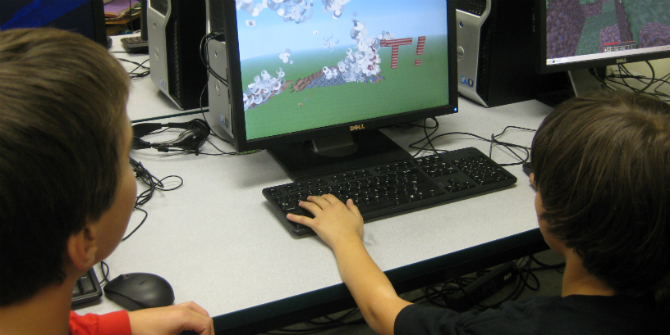 The message for readers of all ages is clear: reading medium matters. Adult readers need to be more critically aware of the choices and reading strategies they use with the different reading media available to them. In this post, Natalia Kucirkova explains why emergent or young readers need to be provided with high-quality print and digital books, and optimal ways for their use at home or schools. Natalia Kucirkova is Professor of Early Childhood Education and Development at the University of Stavanger, Norway and Senior Research Fellow at the University College London, UK. Natalia’s research concerns ways of supporting children’s book reading, digital literacy and exploring the role of personalisation in early years. She co-edits the Bloomsbury Book Series Children’s Reading and Writing on Screen and the journal Literacy published by Wiley. She leads the International Collective of Research and Design in Children’s Digital Books.
The message for readers of all ages is clear: reading medium matters. Adult readers need to be more critically aware of the choices and reading strategies they use with the different reading media available to them. In this post, Natalia Kucirkova explains why emergent or young readers need to be provided with high-quality print and digital books, and optimal ways for their use at home or schools. Natalia Kucirkova is Professor of Early Childhood Education and Development at the University of Stavanger, Norway and Senior Research Fellow at the University College London, UK. Natalia’s research concerns ways of supporting children’s book reading, digital literacy and exploring the role of personalisation in early years. She co-edits the Bloomsbury Book Series Children’s Reading and Writing on Screen and the journal Literacy published by Wiley. She leads the International Collective of Research and Design in Children’s Digital Books.
In her recently published book Reader Come Home, Professor Maryanne Wolf cautions against screens taking over reading on paper. She calls readers to return to the deep reading processes activated when reading on paper and in particular for high-quality, long texts. Professor Wolf is an authority in reading research and currently acts as the director of the Center for Dyslexia, Diverse Learners, and Social Justice in the USA. In her book she has mobilised an impressive body of evidence to highlight how screens affect the reading process. She is worried that the more we read short automated texts on screen, the more our reading shifts towards skimming. This means that we will be less able to read long literary texts and benefit from the cognitive processes that deep reading affords. Wolf zooms in on the “deep reading” processes that, in her definition, consist of internalised knowledge, analogical reasoning, and inference; perspective-taking and empathy; critical analysis and the generation of insight. Wolf’s main argument is that these processes are threatened by the digital medium of reading, notably interactive touchscreens, with distracting hyperlinks.
There is no doubt that reading matters a great deal. To be able to read is to be able to fully participate in the modern society and lead a meaningful life. Teaching children to read and enjoy books is the primary goal of early childhood education. International reading/literacy organisations (e.g. Book Trust), promote the love of reading even before children are born (e.g. Bookstart Bump, read to your bump). For decades, reading researchers have identified barriers to reading and ways of counteracting them. Traditional risk factors include limited access to books at home, or a poor home learning environment. A recent risk factor are screens: tablets, smartphones, video consoles and other modern technologies.
There is a concern in some quarters that children’s activities with screens will replace their reading of books. There is a concern that the habit of skimming digital texts will carry over to reading on paper. These are valid concerns but they are not substantiated by research and they omit the important role of context and individual readers in driving change. Clearly, positioning paper books as superior to digital books offers a more convenient explanation than turning the mirror towards ourselves. Screens were cited as the reason for US teens’ declined interest in reading but as Jordan Shapiro bluntly puts it: “…it is easier to frame the story as paper vs. digital. It gives us permission not to engage with our kids. We can blame the video games and apps rather than blaming ourselves.”
There are many experimental studies that compared reading on paper versus reading on screen and found a difference in readers’ performance. Two meta-analyses summarised the evidence for adult readers (Clinton, 2019 and Delgado et al., 2018) but did not provide explanations for why the difference occurs. There could be a difference because of the way gains were measured (methodological reasons) and/or because of how gains were defined (theoretical reasons). Clinton’s meta-analysis provides some explanation in that it compares fictional and expository texts and detects a negative effect on reading performance for expository texts only. She reflects on the difference and suggests “contextual cue” as a possible reason for different reading performance with reading expository texts on screen. The readers’ awareness of how they read on screen (and the calibration process they engage in when reading on screen), might be the sources of the print-versus-screen difference, Clinton suggests. This process is called meta-cognition and it influences your impressions of how much you understood the text you read, how much you focused on the text, whether you skimmed it or not and many other factors. The calibration process is not dependent on the digital medium but on the readers’ preference: if you prefer to read this blog printed out on a piece of paper, your awareness of reading on a screen is influenced by this preference.
The chain of influences is an essential piece of understanding for the debates on reading on and off-screen. It is a continuation of a long argument in media studies where one camp of researchers focuses on metacognition and another camp of researchers on the inherent characteristics of the medium. Intentionally or not, Wolf follows in footsteps of Herbert Marshall McLuhan, a communication theorist famous in the 1960s, who represents the “medium is the message” camp. In his early writings, McLuhen insisted on the causalities and effects inherent in technologies. In his later writings, McLuhan extended his concern with the digital medium to the trends observable in the modern society such as heightened individualism, nationalism and their threat to democracy. In Reader Come Home, Wolf expands her concern around time spent on screens to wider concerns.
I am not at home with this concern (forgive the pun). To me, Wolf’s engaging writing style makes for enjoyable reading, and the book’s availability as a Kindle and paperback gives me a choice to enjoy it in a format of my preference. In my review of her book, I applaud Wolf’s endeavour to present a clear case on why the concerns around reading on screen need to be addressed by researchers, communities and policy-makers. I suggest giving more voice to research that focuses on features that are present in both print and digital reading, such as interactivity, materiality or personalisation. I also highlight the interplay of content and format in affecting children’s story comprehension and caution that the privileged status of written stories for developing children’s empathy has not been confirmed by research yet.
The ‘home’ that Wolf invites readers to, will be invariably different for different readers. The screen introduced hyperlinks, large collections of e-books, automatic possibility for translation, multimedia representations of meaning. Despite many gloomy predictions, the presence of children’s e-books and story apps generated a surge of interest in children’s print books. Recent research by the National Literacy Trust in the UK shows that it is not the reading medium but readers’ motivation that explains their reading habits: skilled readers read a lot and well both on paper and screen.
It seems to me that before we write the new digital paths off, we need to explore them in more depth. Children and adults have different experiences with screen media. With young children, it is parents’ attitudes towards children’s e-books that mediate their access of books and length of time they spend with them (perhaps not surprisingly parents of youngest children prefer print books). For children born after 2010, seeing their family members reading on screen is as common, if not more common, than reading on paper. Their first encounter with stories, written, audio, visual and multimedia, happens as much with as without screens. These children are less aware of the disconnect between a digital and non-digital reading medium than any generation of children before them. It follows that they have different preferences, different resources for calibration, different lived examples of reading around them. Given the widely reported low quality of children’s e-books, our research group focuses on maximising the learning opportunities with digital books and encouraging more and high-quality reading in local languages.
Without a doubt, readers will not be able to enjoy new reading adventures if they do not have a solid foundation. But as for how and where the reading adventures take us, there are courses for horses: different books work for different readers. The ‘home sweet home’ for reading in the digital age is the provision of, and the practice in the use, of high-quality texts on and off screen.
This post gives the views of the authors and does not represent the position of the LSE Parenting for a Digital Future blog, nor of the London School of Economics and Political Science.





